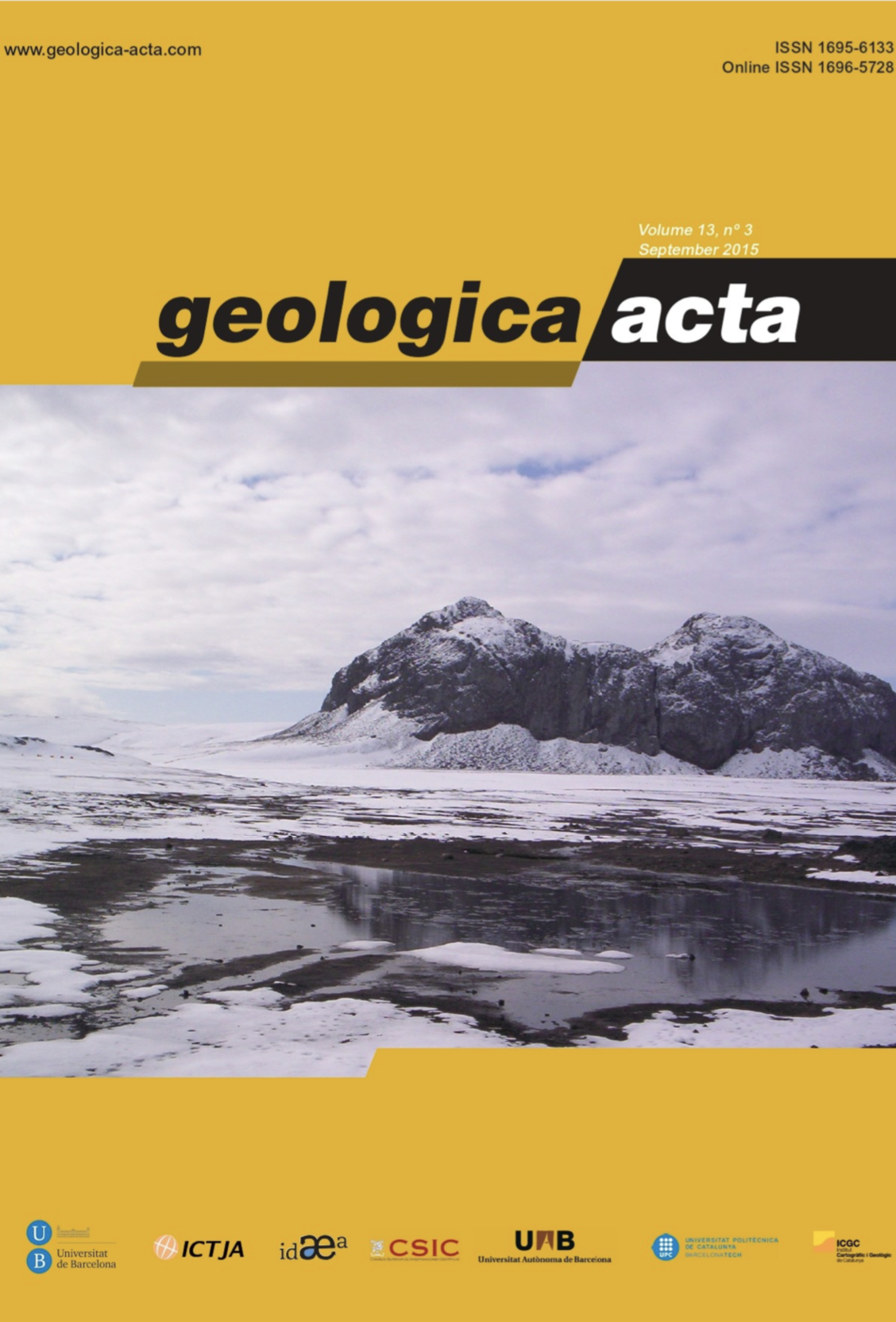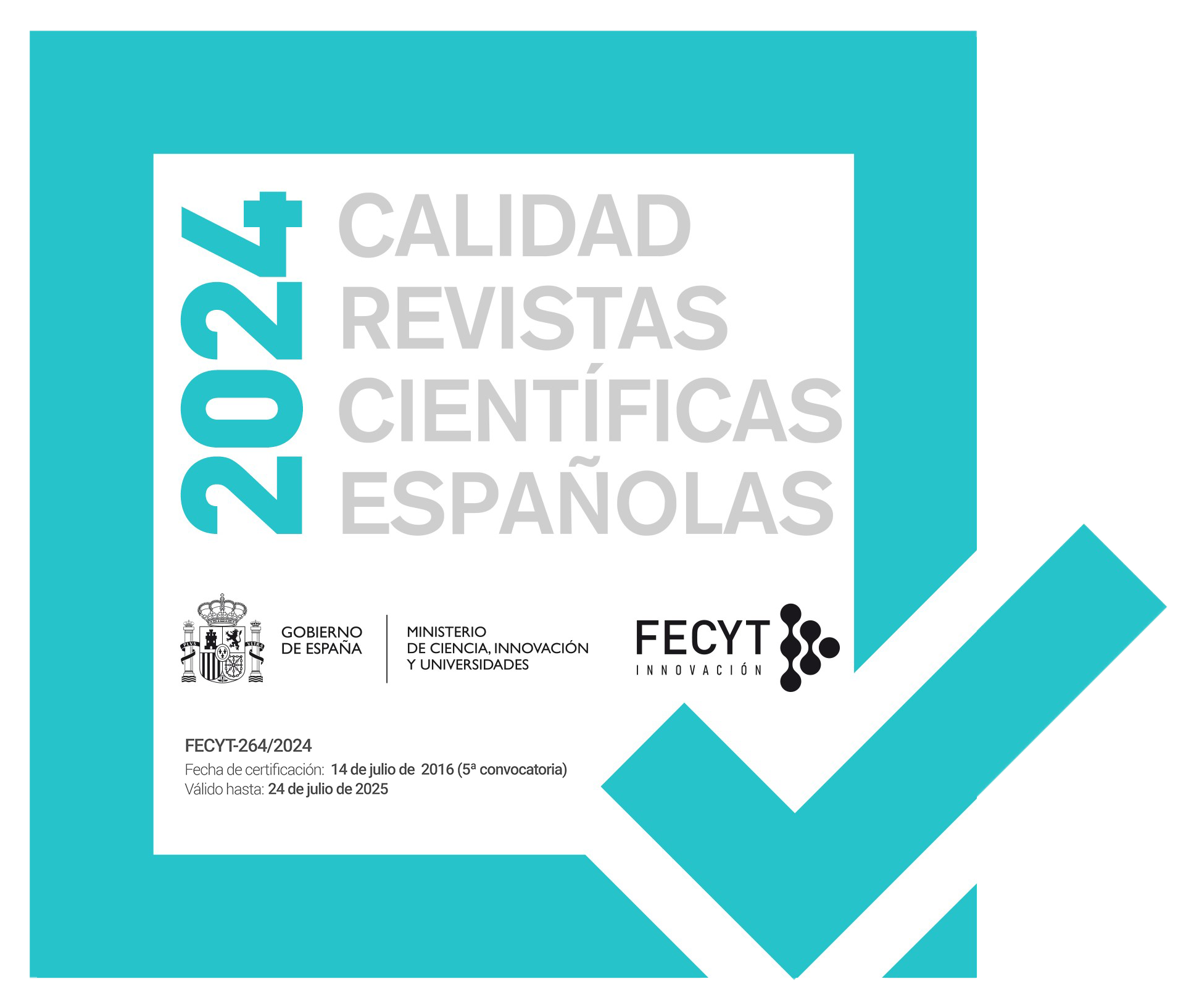Megalodon, mako shark and planktonic foraminifera from the continental shelf off Portugal and their age
DOI:
https://doi.org/10.1344/GeologicaActa2015.13.3.1Keywords:
Megalodont, Mako shark, Planktic foraminifera, Continental shelf, AgeAbstract
Turbidite fragments collected by a fishing net off the central Portuguese coast (Peniche) present some fossils. The matrix is phosphatized and iron-rich with small quantities of manganese, zinc and copper. The occurrence of Megaselachus megalodon most probably excludes an age older than Middle Miocene. Its very advanced evolution stage is consistent with a Pliocene age. Based on planktonic foraminifera in depressions of cetacean skulls recovered in the same way, from the same area, the age of sharks and cetaceans is likely to range from latest Messinian to Early Pliocene. Condensed sedimentation is revealed by the co-occurrence of typical Late Pliocene and Quaternary foraminifera. Lack of benthic foraminifera suggests more or less deep environments, while a scallop, Mimachlamys varia, indicates nearby rocky substrate. The mako shark Isurus cf. oxyrhinchus is recorded in the area for the first time. The shark association represents a moderately warm environment as M. megalodon and Isurus are essentially temperate water dwellers, while no warm water form is known. Early Pliocene planktonic foraminifera point out to temperate to subtropical waters. Hence temperate to moderately warm conditions seem to have prevailed.
References
Adnet, S., Balbino, A.C., Antunes, M.T., Marín-Ferrer, J.M., 2009. New fossil teeth of the White Shark (Carcharodon carcharias) from the Early Pliocene of Spain. Implication for its paleoecology in the Mediterranean. Neues Jahrbuch für
Geologie und Paläontologie, 256(1), 7-16.
Agassiz, L., 1843. Recherches sur les poissons fossils. Neuchâtel, 1-390.
Antunes, M.T., 1978. Faunes ichthyologiques du Néogène supérieur d’Angola, leur âge, remarques sur le Pliocène marin en Afrique australe. Lisboa, Ciências da Terra (UNL), 4, 59-90.
Antunes, M.T., Balbino, A.C., 2003. Uppermost Miocene Lamniform Selachians (Pisces) from the Alvalade basin (Portugal). Lisboa, Ciências da Terra (UNL), 15, 141-154.
Antunes, M.T., Balbino, A.C., 2010. The great white shark Carcharodon carcharias (Linné, 1758) in the Pliocene of Portugal and its Early distribution in western Atlantic. Revista Española de Paleontología, 25(1), 1-6.
Applegate, S.P., Espinosa-Arrubarrena, L., 1996. The fossil history of Carcharodon and its possible ancestor, Cretolamna: a study in tooth identification. In great white sharks. The biology of Carcharodon carcharias. San Diego CA, USA, Peter Klimley and David Ainley eds. Academic Press, 4, 19-36.
Bianucci, G., Miján, I., Lambert, O., Post, K., Mateus, O., 2013. Bizarre fossil beaked whales (Odontoceti, Ziphiidae) fished from the Atlantic Ocean floor off the Iberian Peninsula. Geodiversitas, 35(1), 105-153.
Berggren, W.A., Kent, D.V., Swisher III, C.C., Aubry, M.P., 1995. A revised Cenozoic geochronology and chronostratigraphy. In: Berggren, W.A., Kent, D.V., Aubry, M.-P., Hardenbol, J. (eds.), Geochronology, Time Scales and Global StratigraphicCorrelation: A Unified Temporal Framework for an Historical Geology, SEPM Spececial Publication, 54, 129-212.
Bruyne, R.H.de, 2003. The complete Encyclopedia of shells. REBO Publishers, Lisse, 336pp.
Cappetta, H., 1987. Chondrichthyes II/Mesozoic and Cenozoic Elasmobranchii. Handbook of Paleoichthyology. Edited by Prof. Dr. H.-P. Schultze, Lawrence. Gustav Fischer Verlag. Stuttgart. New York. 38, 123pp.
Cappetta, H., 2006. Elasmobranchii Post-Tradici (Index specierum et generum). Fossilium Catalogus I. Animalia. Edited by Wolfgang Riegraf. Pars 142. Backhuys Publishers, Leiden, 472pp.
Charlesworth, E., 1837. Notice of the teeth of Carcharias megalodon occurring in the Red Crag of Suffolk. Magazine of Natural History, 1(2), 225-227.
Compagno, L., 2005. Check list of living Chondrichthyes. In: W.C. Hamlett (Ed.), Reproductive biology and phylogeny of Chondrichthyes: sharks, batoids and chimaeras. Science Publishers, Enfield, 503-548.
De Kluijver, M.J., Ingalsuo, S.S., de Bruyne, R.H., 2000. Macrobenthos of the North Sea [CD-ROM]: 1. Keys to Mollusca and Brachiopoda. World Biodiversity Database CD-ROM Series. Expert Center for Taxonomic Identification (ETI), Amsterdam.
García, E.X.M., Antunes, M.T., Balbino, A.C., Muñoz, F.R., Llovera, J.C., 2009. Los tiburones Lamniformes (Chondrichthyes, Galeomorphii) del Plioceno inferior de la Formación Arenas de Huelva, suroeste de la cuenca del Guadalquivir, España. Revista Mexicana de Ciências Geológicas, 26(3), 674-686.
Glückman, L.S., 1964. Class Chondrichthyes, Subclass Elasmobranchii. In: Obruchev D. V. (Ed.) Fundamentals of Paleontology. Acad. Nauk SSSR 11, 196-237.
Gottfried, M. D., Compagno, L.J.V., Bowman, S.C., 1996. Size and Skeletal Anatomy of the Giant “Megatooth” Shark Carcharodon megalodon. Great White Sharks/The Biology of Carcharodon carcharias. San Diego CA, USA, Peter Klimley and David Ainley eds. Academic Press, 7, 55-66.
Huddlestun, P., 1984. Planktonic foraminiferal biostratigraphy, Deep Sea Drilling Project Leg 81. IN DSDP vol. LXXXI, 429-438.
Jordan, D.S., Hannibal, H., 1923. Fossil sharks and rays of the Pacific slope of North America. Bulletin of the Southern California Academy of Sciences, 22, 27-68.
Kennett, J.P., Srinivasan, M.S., 1983. Neogene Planktonic Foraminifera-A Phylogenetic Atlas. Stroudsburg: Hutchinson Ross, 265pp.
Leriche, M., 1926. Les Poissons néogènes de la Belgique. Mémoires du Musée royal d’histoire naturelle de Belgique, VIII(32), 364-472.
Leriche, M., 1942. Contribution à l’étude des faunes ichthyologiques marines des terrains tertiaires de la plaine côtière atlantique et du centre des États-Unis. Le synchronisme des formations tertiaires des deux côtés de l’Atlantique. Mémoires de la Société géologique de France, nouvelle série, XX(45), 111pp.
Leriche, M., 1957. Les Poissons néogènes de la Bretagne, de l’Anjou et de la Touraine. Mémoires de la Société géologique
de France, nouvelle série, XXXVI(81), 64pp.
Lourens, L.J., Hilgen, F.J., Shackleton, N.J., Laskar, J., Wilson, D., 2004. The Neogene Period. In: Gradstein, F. M., Ogg, J.G. and Smith, A.G. (eds.). Geological Time Scale 2004. Cambridge University Press, 409-440.
Moore, R.C., 1965. Brachiopoda. Treatise on Invertebrate Paleontology. Part H., Volume 1. Boulder, Colorado/Lawrence, Kansas: Geological Society of America/University of Kansas Press, H6-H93.
Müller, J., Henle, F.G.J., 1841. Systematische Beschreibung der Plagiostomen. Berlin, Veit, 1-200.
Pimiento, C., Clements, C.F., 2014. When did Carcharocles megalodon become extint? A new analysis of the fossil record. PLoS ONE, 9(10): e111086.
Purdy, R.W., 1996. Paleoecology of Fossil White Sharks. Great White Sharks/The Biology of Carcharodon carcharias. San Diego CA, USA, Peter Klimley and David Ainley eds. Academic Press, 8: 67-78.
Rafinesque, C.S., 1810. Caratteri di alcuni nuovi generi e nuovi specie di animali e piante della Sicilia, con varie asservationi
sopra di medesimi. Palermo, 1-105.
Scott, G.H., Kennett, J.P., Wilson, K.J., Hayward, B.W., 2007. Globorotalia puncticulata: Population divergence, dispersal and extinction related to Pliocene–Quaternary water masses, Marine Micropaleontology, 62(4), 235-253.
Downloads
Published
Issue
Section
License

This work is licensed under a Creative Commons Attribution-ShareAlike 4.0 International License.
Copyright
Geologica Acta is the property of the UB, GEO3BCN, IDAEA and UAB. Geologica Acta must be cited for any partial or full reproduction. Papers are distributed under the Attribution-Share Alike Creative Commons License. This license allows anyone to reproduce and disseminate the content of the journal and even make derivative works crediting authorship and provenance and distributing possible derivative works under the same or an equivalent license.
Author Rights
Authors retain the copyright on their papers and are authorized to post them on their own web pages or institutional repositories. The copyright was retained by the journal from the year 2003 until 2009. In all cases, the complete citation and a link to the Digital Object Identifier (DOI) of the article must be included.
The authors can use excerpts or reproduce illustrations of their papers in other works without prior permission from Geologica Acta provided the source of the paper including the complete citation is fully acknowledged.




